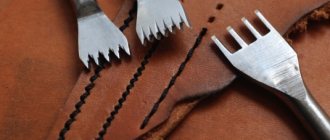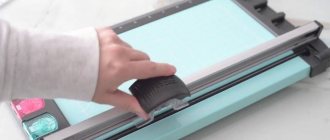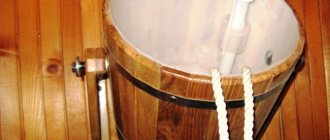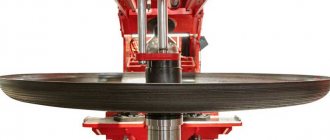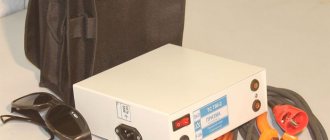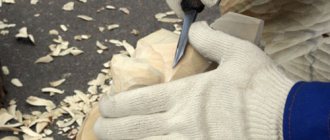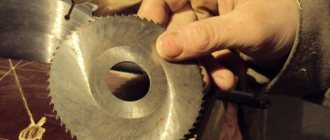This publication presents three tool options for punching holes in sheet metal . If you want to find out what exact templates and drawings to make a hole punch for your workshop, then watch the video of the “Garage 91 Gomel” channel at the very end of the article.
Another master, Ilya Konakov, made a video on his channel about how to make a hand-held hole punch that can easily handle sheet metal. The idea arose during the work on replacing the bottom on the nine. Those who do body repair know what it means to drill a lot of holes.
Everything is welded through the holes. In order not to do this with a screwdriver or drill, the master decided to improve the technology. The firmware took approximately 3 hours. Available materials were used. The video shows the entire mechanism and what it is made of. How to work with sheet metal. The force is small, although it is advisable to press the hole punch with both hands. The holes are 7 millimeters.
The tip is sharpened like a stationery hole punch. The master took the roller from the bearing and hammered it inside. Sharpened it with a hollow. More than one hundred holes were made using this mechanism. The result is a convenient tool for car repair and not only for that.
Another model of a homemade hole punch for metal. This is a hand tool for making holes in plastic, iron, paper, textolite. No drill required. The master shows how convenient it is to work with this tool; no irregularities, burrs, etc. are formed.
Convenient to use in the workshop or at home for installing plasterboard panels. You can also punch holes and install rivets in the same way. The dragon's honor that pierces the metal is called a sleeve. It can be of different sizes. In the previous video it was 7 millimeters, here it is 5. The sleeve also comes in smaller sizes, for example 2, 3 millimeters. Some copies have a window for working with non-standard sheets and parts. Another homemade model of a hole punch - a cutter for metal (Vlad ShchCh channel). What are its features? There is a hole, it is planned to make an adjusting plate and tighten it with a screw. Using this part you can change the depth of the hole. The top part is removable. It can be changed. There are several different options you can make. The master explained what parts the rest of the instrument consists of.
The last video shows the dimensions of the hole punch and how it performed in operation.
A punch is a tool designed for making holes in metal, leather, cardboard and other thin sheet materials. It has a pointed edge, thanks to which it cuts into the surface, creating a hole with ideal geometry. The result obtained from the work of such a tool looks better than when using a drill or awl.
Leather punches
The vast majority of punches are used by leatherworkers. These tools are used to perform various types of work in preparing the leather before stitching it. The fact is that such material has great rigidity, so a significant part of the manipulations for its processing can only be carried out using punches.
Such a tool can be used not only when working with leather, but also with tarpaulin, leatherette, denim and other types of dense fabric.
The punches used by leatherworkers are:
- Lowercase.
- Revolving.
- Ring.
- Curly.
- End
Line punch
The high density of leather does not allow it to be sewn using ordinary sewing equipment . The needle is simply not able to pierce such dense material. To solve this problem, a line punch is used. Based on the principle of operation, such devices can be divided into two fundamentally different types. The first one works like a cutter, simply pressing in and piercing the exit hole, pushing the material apart. In fact, the principle of operation is similar to an ordinary awl. The second type of punch cuts a small cavity, completely removing the material. As a result of its application, a neat hole remains.
The holes resulting from the use of such a tool are subsequently stitched with thread. Line punches usually resemble a dinner fork or comb. Their protruding spines are arranged in one line. The same distance is maintained between them. The tool can be equipped with from 1 to 6 needles. mallet is struck at the end of the punch. The sharp spikes cut into the material, piercing or punching a hole in it.
Read also: How to polish a stainless pipe
The shape of the punch pins may vary. They can be round, triangular, diamond-shaped, rectangular or oblique.
Also important is the cross-sectional thickness of the needles themselves and the distance between them. Smaller ones, for example, such as oblique punches used for French seams, are usually chosen for sewing watch straps, as well as wallets. A cutter with a large diameter of tenons and an increased pitch is suitable for coarser products when the seam needs to be made using thick threads. There is no completely universal device, so each master has at least several sets with different combs.
The more spikes on the line cutter, the faster you can prepare a line for sewing. First, the instrument is placed in place and a blow or several are struck. When he punches a hole, the spikes are removed and the comb is moved so that the last needle enters the outermost of the previously made holes. In this way, it is possible to maintain an even pitch for the further seam.
When working with a tool that has many needles, you will have to make stronger blows to pierce the skin, and also make an effort to pull the spines back. A punch with one or two needles is designed for preparing stitches in narrow places where a 6-pin tool cannot fit.
Less accurate in operation are punches made on the pliers principle. In them, the combs are located on two jaws. The peculiarity of using such a tool is the absence of noise, unlike blows with a mallet. The combs are aligned along the line of the future seam and the handles are compressed, piercing the leather or fabric.
Revolver punches
Tools of this type are pliers, in which a revolver with screwed-in punches for piercing is attached to one jaw. Before using the punch, you need to turn the revolver so as to install the desired type of spike opposite the second jaw. After this, material is placed between the jaws. The punch compresses, punching a hole. Typically, 6 spikes with a diameter of 2 to 4.5 mm are attached to the revolver. To prevent the revolver from turning, there is a special lock on the body.
The use of such a tool makes it possible to punch only one hole at a time, so punches of this type are not suitable for forming a seam. The main purpose of such equipment is to create small holes, for example, on a waist belt. Some revolving devices provide the ability to remove the spikes. This allows you to install various accessories, including devices for mounting buttons and eyelets on clothing.
Ring and figured punches
Tools of this type allow you to punch holes while removing part of the material that falls into their internal cavity. Such equipment makes it possible to prepare larger slots. Typically, a ring or shaped punch is a tube, one end of which is pointed. The principle of operation of such equipment is to apply the pointed part to the material and strike the end of the tool.
The range of shapes and sizes of punches of this type is very extensive. In addition to the circle, such tools can repeat the outlines of a star, eye, oval, rhombus, butterfly, and so on. Round punches of this type are usually sold in sets of 15 pieces. The equipment is represented by tubes with a diameter from 2 to 22 mm. Shaped devices are usually sold separately.
End punches
There are also tools designed for trimming leather. In particular, belt end punches are produced in a fairly wide range. They are a pointed steel plate bent along a certain contour. It is used for cutting leather strips in the manufacture of waist belts. A similar tool also exists in other forms.
Punchers for wads
A tool for cutting out wads used for loading cartridges is offered separately for sale. Externally, it almost completely corresponds to ring punches for leather. Such a device has a diameter corresponding to the caliber of cartridges for which wads need to be prepared. The main difference between a hunting punch is that its main purpose is not to make a hole, but to cut out circles of material. Its design provides a technological hole on the side of the tube, which allows you to remove wads falling into it. Such a tool rarely needs sharpening, since it works with relatively softer materials such as cardboard and felt.
Metal punches
Equipment designed for working with sheet metal is represented by almost as wide a range as for leather. In addition to hand tools, this group also includes mechanized devices. In general, all metal punches can be divided into three types:
Read also: How to drill a stud from a head
Pneumatic
Such equipment requires connection to a compressor . It is used not only for working with thin sheet metal, but also metal tiles, metal profiles and other sheet metal. The capabilities of such a tool are very limited, but with its use it is possible to maintain a fairly high level of labor productivity.
Hydraulic
A hydraulic punch is more like a machine tool than any other piece of equipment. It can prepare holes on thick metal up to a cross-section of several millimeters. The resulting hole looks just perfect compared to the result that can be obtained from drilling. Such machines provide the ability to install various punches. Thus, the equipment makes it possible to change the equipment to create holes of the required parameters.
Manual punches
Tools of this class are very similar to equipment used in leather processing, although they have certain differences. First of all, they are made from very hard tool steel. The body of the tube of such a tool is much thicker, so it is less prone to deformation under strong resistance from the material into which it is being cut. Such punches can be either a completely manual tool or a slightly mechanized one mounted on pliers.
The vast majority of hand-held equipment is a steel tube with a sharpened edge on one end. Often the tool is equipped with a plastic or rubber handle. Its presence allows you to reduce the ringing from hitting the tool with a hammer during operation.
A punch designed for working with metal quickly loses its sharpness. In this regard, to maintain their effectiveness, it is necessary to periodically sharpen the instruments. To do this, it is often necessary to process not only the outside of the punch tube, but also polish the internal cavity. The easiest way to do this is to use an engraver . Small polishing attachments, as well as abrasive equipment, make it possible to speed up the process many times over, compared to using ordinary small files .
A metal punch is an indispensable tool in metalworking. With its help, you can make a hole of an ideal shape without deforming the edges of the metal and changing properties caused by temperature effects on the surface. In addition to metal products, the hole punch will do an excellent job with other materials: plywood, plastic or leather.
How does an edge bending machine work?
Structurally, a metal bending machine consists of several parts:
- supporting surface,
- working base,
- clamping element
- crimping punch,
- levers-handles.
Some models are equipped with a hole punch and a knife for trimming edges. In the standard design, the supporting plane measuring 1m x 1.5m is a table made of wood or metal with powerful legs. The horizontal fastening of the base is made from channel No. 8 or 6.5. Metal structures are connected by welding, and wooden structures are connected by bolts.
Clamp
To clamp the surface when bending the edges, the device is equipped with a pressure bar - an angle with a shelf of 0.05 m. It presses against the punch at a given angle. Holes for bolts are drilled on both sides of the clamping mechanism. Also for clamping, “lambs” with pins welded to the base are used. More complex clamping parts are equipped with springs.
Punch
To make a punch, a square section of pipe is often used. The design of a part involves its horizontal rotation around an axis. In this case, the upper edge in front of the base exactly coincides with the punch.
For this purpose, the ends are equipped with loops. The clamp is located exactly vertically so that there are no distortions when bending metal. The punch is adjacent to the edge of the base without gaps so that the fold line is accurate. When not in use, the top edge of the punch is located in the same plane as the table plane. If the design has deviations, the fixture will work, but with an increased bend radius, which leads to a rounded straight line.
Drive unit
A manual drive made from a pair of pipe sections is connected by welding to the front or side of the punch. It can be in the form of a bracket or a telescopic lever. The length of the lever is firmly fixed for specific positions using pins connecting through the holes in increments of 0.1 m. This handle helps to distribute the load evenly, adjusting the force on the surface depending on its thickness. For example, the telescopic shape of the lever during body work allows you to increase the effort by more than 2 times.
Tinsmith's Tool
Such an edge bender is necessary during auto repair for a smooth transition of the metal patch to the base. After straightening, both planes must be coaxial with each other.
On a thin sheet of iron, it is impossible to guarantee the reliability of the butt weld joint. The device allows you to prepare an edge profile for overlap welding. It greatly simplifies the process of repairing a car body if you need to bend the metal at an angle of 90 degrees, i.e. make an edge or flange. Edge bending devices for auto repair are characterized by a simple design and low price, so making them yourself is not always impractical. Sometimes it is better to buy equipment for which there is an additional use in the household.
Video instructions on how to use a tinsmith's edge bender
Hole punches - what is the difference from a countersink?
A countersink is a multi-blade cutting tool that is used to machine cylindrical and conical holes in parts. The purpose of this work is to increase the diameter, improve not only the surface quality, but also the accuracy of the hole dimensions. Any actions performed by this tool are called countersinking, or rather, it is semi-clean processing of a hole by cutting off small defects. A countersink punch is a tool that combines two functions at once. The sharp tip allows you to immediately punch holes, and the built-in blades expand them to the desired diameter .
The countersinking process is a precision machining operation that requires high power. Often such work can only be performed using special machines. Drilling machines of all types are suitable for this (these are the most common jobs), turning machines, boring machines (as secondary operations), milling machines (both horizontal and vertical, but they are rarely used, only as one part of the program), modular machines (this may be one of the operations in the automatic line).
A standard tool consists of a cutting part, working and calibrating parts, a neck and a shank. The cutting part is made in such a way that the main cutting edges are located on it. They are always located at a certain angle. The size of the angle depends on the purpose and type of countersink punch. Typically, if they are used for ductile metals, the angle should be about 15 degrees, and if for brittle metals - about 5 degrees.
Areas of application
Metal bending devices are used in various industries. They are used to create folds from roofing iron, make rectangular air ducts from tin or metal sheets, prepare the edges of products for welding, and parts of geometric shapes. Manual edge benders are actively used for construction and repair work. They are in demand during car repairs.
Among the advantages of this technology, in addition to the small thickness of the resulting edges and the low cost of rolled metal, one should add high resistance to wear.
Pneumatic edge bender
Particularly popular among craftsmen are edge benders with pneumatic drive, which work as a “rotary beam”. The pneumatic drive contributes to significant pressure (up to 6.2 bar) on the workpiece. But such equipment can be used when working with sheet metal no thicker than 1.2 mm. In this case, the edge width will be no more than 12 mm.
If you want to make a pneumatic machine with your own hands, you must take into account that its operation requires an air flow of at least 113 l/min.
Pneumatic punch
This is a universal tool model. On one side, the structure is equipped with a mechanism for punching holes, on the other, with jaws for forming an edge.
Thanks to this, you can simultaneously bend the edge and make holes in the metal for fasteners. That is why the tool is often called a pneumatic punch. Its working part is made of high-speed steel. The rubberized handles of the product are equipped with springs. They help reduce pressure on the palm, which facilitates the process of punching and processing.
Any model of hole punch-edge bender works much faster and more efficiently than its manual counterparts, which is why it is intensively used at service stations and car repair shops.
Main varieties
Edge bending equipment is available in the form of mobile and stationary models. The designs of the machines are massive and practically cannot be disassembled.
They are mounted directly at the place of use, and are moved only with the help of technical means.
A special place in the product line belongs to segmented manual devices intended for the manufacture of cases, boxes, i.e. products “closed” on all sides.” Due to the different configurations, the segments can be installed arbitrarily. Such equipment allows you to obtain any bending length that does not exceed the working length of the machine.
Tool models differ from each other not only in power, efficiency and thickness of the materials processed, but also in the type of metal.
Portable models of edge benders with gradual shaping consist of:
Roller-type hand-held products have the simplest design. The whole process is carried out by a handle, and the main task of deforming the metal is performed by rollers. The bending width is regulated by a special limiter installed on the tool guides.
In a roller edge bender, friction during sliding of the jaws replaces rolling friction during rotation of the rollers. In this case, the forming force is significantly reduced, but the design of the tool is less universal, because it is impossible to change the edge formation parameters due to one pair of rollers. In addition, edge benders with rollers do not make it possible to carry out beading of small radii inside the product.
A significant disadvantage of portable models of hand tools is their lack of accuracy. As the device moves along the line of the future edge, the error gradually increases, which can reach more than a millimeter. This is unacceptable for work such as auto body repair, so the quality of the edges depends on the experience of the specialist. Because of these technical characteristics, it is advisable to use a roller edge bender only for solving simple problems.
A machine with a hydraulic drive is more functional. Thanks to its high power, it copes well with workpieces made of metal sheets, even of considerable thickness.
What features to consider when choosing
From a huge assortment, you need to choose those that meet all the needs of your workflow and can demonstrate a positive result. To do this, we will consider all the nuances in detail before purchasing.
It is important to understand that the diameter of the standard hole in hole punches is 5.5 mm, and the distance does not exceed 80 mm.
| Soldering iron | A soldering iron can also replace a hole punch only in certain cases. They can easily make a hole in a sheet of plastic. In this case, it is important to carefully monitor how hot the soldering iron is; if you are careless, you can make a large hole and get burned. |
| With a nail | You can make a hole of the required size in paper or other thin material with a regular nail. When working with plastic, it must be preheated. |
| With a small screwdriver | Such a tool is useful only if a hole needs to be made in plastic. |
| What to pay attention to | |
| Number of holes | Often they choose a device that punches 2 or 4 holes at the same time. Ideal for binding documents and A4 paper. Their feature allows you to create holes that exactly match the position of the fasteners and rings on the folders. However, you can also choose individual options from 1 to 12 holes at a time. |
| Knife sharpness | The main point is the sharpness of the blades. Punch any sheet of paper folded several times. If the edges of the hole are uneven, then the punches have low sharpness. |
| Material type | For continuous use, it is better to choose products made of metal or durable plastic. Before purchasing, check the elasticity of the sole to prevent scratches on your desktop. |
| Power | For 10-12 sheets you need a compact device with minimal power. Up to 150 sheets are common in office spaces. |
| Additional functions | Many models have a retractable ruler, and if you use such a hole punch correctly, then on the next batch of paper you can make both hole sizes at the same distance, and at different ones. |
| It is also worth considering a container for waste so as not to pollute the space. It can be retractable or removable. | |
| For continuous use, it is recommended to purchase a device with replaceable spare parts. Since the disks and cutting head bear the main load, they wear out more often. But even if something breaks down, you can easily change it yourself. | |
| Many models have a cutting head adjustment function. The convenience is that you can make a large or small distance between the holes of the hole punch. |
How to make a rectangular leather punch with your own hands
Leather punches are not so easy to find on the open market.
And rectangular ones even more so. I once urgently needed rectangular punches on a day off. There was nowhere to get it from, and there was no time to order via the Internet - watch straps with such holes had to be sent to customers the next day.
An inquisitive mind, innate ingenuity and great internet. In general, I decided to make the punches myself.
I found a couple of long screws and a metal tube of approximately the right internal diameter in the garage.
We immediately need to make a reservation - everything was done practically on the knee, without the use of special tools.
The first thing I did was prepare the future punches by sawing off two pieces of the required length from the found tube. I did everything in a hurry and chose the length of the punches by eye, so that there would be something to hold it on and it would be safe for my fingers to hit with a hammer.
Yes, I still hit my finger :).
Then, using emery, I made a kind of matrix from a metal screw, which was necessary for hot forming the rectangular cross-section of the punch. I made the following mandrels according to the required dimensions.
The holes in the straps were of two sizes. Therefore, the punches were of two sizes.
The next step is long and painstaking. It is necessary to heat the tip of the future punch until red and while it is hot, hammer a sharpened pin called a matrix inside. Slowly and repeatedly. He warmed it up, quickly clamped the workpiece in a vice, and hammered the pin. And so on in a circle. Until the inner hole of the punch takes the desired configuration.
Then, after allowing the workpiece to cool slightly, we process the outer surface of the tip of the punch using sandpaper, giving it a rectangular and pointed shape.
After this, we sharpen it with a needle file and use a small sharpening stone to bring the cutting edge of the future punch to the required sharpness
That's it, the end of the torment. The cutting edge remains hardened.
To do this, we again heat the pointed tip of the punch until red and lower it into the oil in short, quick dives, gradually slowing down and making slow and smooth dives.
Then, when the workpiece has cooled, cool it completely by immersing it in cold water or placing it under running cold water.
All. Congratulations! We made it!
To be honest, I did it just once, but in the end I took these punches out of the depths of the tool box and used them a couple more times in my work.
I hope my experience will help you cope in a difficult situation, and I ask “metallurgists” and professional blacksmiths not to criticize too much



